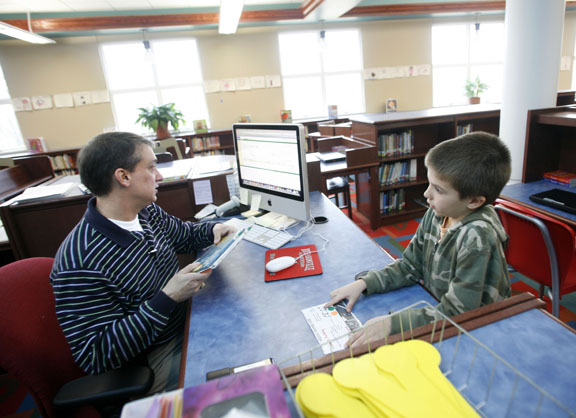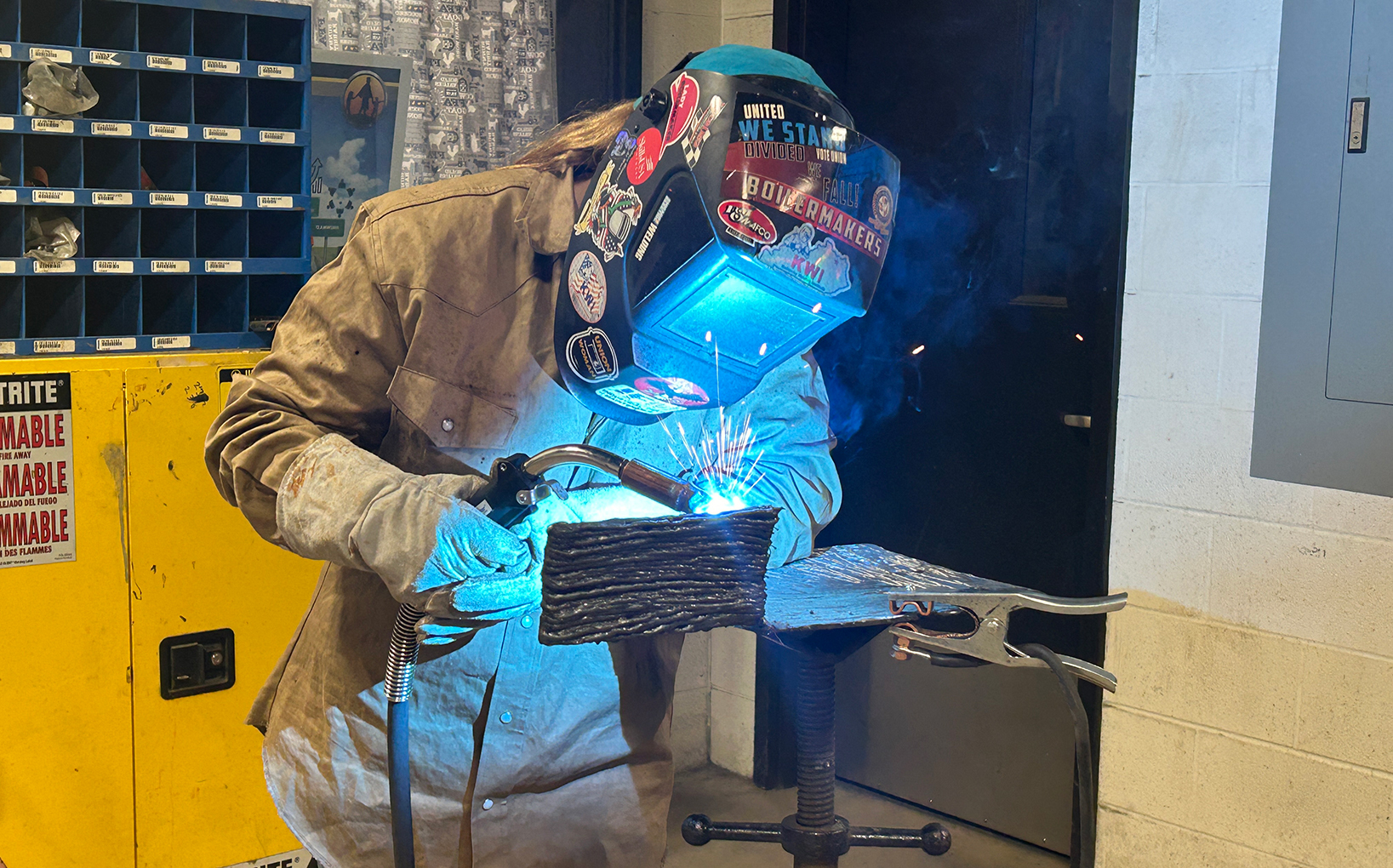
Library media specialist Barry Sanders checks out a book for 2nd-grade student Jacob Kubeny at Richardsville Elementary School (Warren County). The library is filled with natural light. Photo by Amy Wallot, March 2011
By Matthew Tungate
Richardsville Elementary School (Warren County) is so cool it had snowmen in its entryway well into March. But these snowmen weren’t made of snow. Students in every grade made the snowmen of recyclable materials such as aluminum foil and newspaper to raise money for a new playground, and the snowman who received the most donations won.
But the school is cool, literally and figuratively. The geothermal heating system is just one of the many “green” technologies the nearly $15 million, 77,466-square-foot building has incorporated that will make it the nation’s first “net-zero” school – it will use equal or less energy than it produces, saving the school money and the planet resources.
The school’s energy team of 48 4th-, 5th- and 6th-grade students can give 17 presentations on various environmentally friendly aspects of the building, according to curriculum coordinator Manesha Ford.
She began working with the students three years before the school opened Sept. 27 of last year.
“It really prepared them for the year to be leaders for the other kids,” Ford said.
One of the first things you notice about Richardsville Elementary is how much natural light flows through the numerous windows.
Solar tubes (which are like skylights but in tube shape) light the hallways, even on cloudy days. On sunny days they are so bright the electric lights shut off to save energy, Ford said.
Ceilings are angled to reflect light into the classrooms, where the tops of walls are painted white to reflect that light all over the room, she said. A clerestory (a row of windows near the ceiling) lets light in through the library, cafeteria and gymnasium and runs the length of the building.
The building uses light to create electricity as well as to save it. The building’s roof sports solar panels, and once a yet-to-be-built shade structure in the parking lot is covered in solar panels, the school will become net-zero, Ford said.
In the future two television screens in the lobby will have real-time data about how much energy the building is consuming – and producing.
The building also is smart about how it uses and conserves water. The restrooms have hands-free sinks that use light from the building to power them. When it rains, students can watch the water drain through clear tubes that run to the school’s bioswale, or rain garden, that serves as the end of the line for the school’s rainwater collection system.
There are lots of other things the school has done, too: using concrete floors that need no waxing; carpet tiles that can be replaced individually rather than having to send a whole rug to a landfill; and laptop and iPad carts instead of an energy-sucking computer lab. Even the walls are built in a green way.
Fourth-grade teacher Stephanie Lee thinks the students benefit since every part of the building is hands-on and incorporates visual learning.
“Our students get to see things they wouldn’t normally see, such as solar tubes and active day lighting,” she said.
All of these green strategies have been used in other buildings, Principal Kory Twyman said.
“This is really the first time that all of these things have been brought together in one place to be utilized within a school,” he said. “This is the first building like this in the nation. I don’t think it’s going to be the last.”
Twyman said teachers and students still are getting used to the new building, which replaces a 64-year-old building. For instance, teachers have much more storage space in their classrooms and more than one electrical outlet, he said.
Next year teachers will use lesson plans that incorporate murals in each of the school’s themed hallways:
recycling, geo-thermal, solar and water conservation, Ford said.
“So it really is integrating our building into our children’s thinking,” she said.
Preschool teacher Judy Thomas said her students don’t fully understand all they are seeing – they like watching the water run through the tubes, but they thought the bioswale was dug out for swimming pools.
That doesn’t mean that teaching them resource conservation early isn’t important, she said.
“If we start teaching them recycling now, then when they get older that’s just going to be a natural part of life – like two plus two is four, recycling is going to be just like math or anything else,” Thomas said. “Taking care of our environment is important. So if we teach that from early age, it will be instilled in them and will be better for our planet.”
Ultimately, school staff know the 450 pre-K through 6th-grade students are internalizing what they are seeing, Twyman said.
“We even hear parents coming by and saying, ‘Our kids have really changed the way we do things.’ That’s the beautiful thing about education,” he said.
Ford said she has become more green in her own life, such as turning off lights when she leaves a room and recycling.
“It’s not any harder to throw that paper in the recycling bin than in is to throw it in the trash,” she said. “It’s just changing my thinking and understanding that.”
School staff joke with each other about being “tree huggers,” Twyman said, but they know how their building can affect many other places.
“To make it a school, you’re trying to find every opportunity that you can to teach kids not just about what’s in the curriculum and core content, but life lessons in general,” he said. “You’re looking out not for just what they’re doing for the time they’re here in elementary school; you’re looking at 20 years down the road when they are members of this community or wherever they are and you want them to be productive and you want them to be doing everything they can – not to be a tree hugger – but to make their responsibility known and to utilize what they’ve learned to make it a better place.”
MORE INFO …
Kory Twyman, kory.twyman@warren.kyschools.us, (270) 777-3232









Leave A Comment